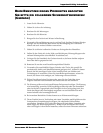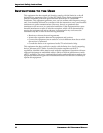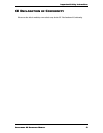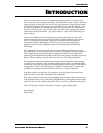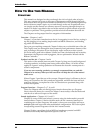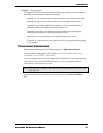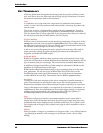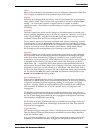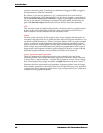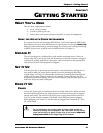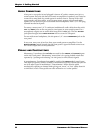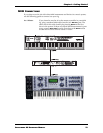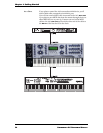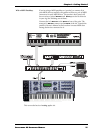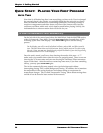
Introduction
ANDROMEDA A6 REFERENCE MANUAL 19
Offset
Many of the Andromeda A6’s parameters have an additional adjustment called offset.
This is simply an adjustment of the parameter by a fixed amount
Default
When the A6 is shipped from the factory, each of its parameters has a pre-assigned
value called a default. This is so that when a parameter is selected, it displays some
setting – on or off status, positive or negative status, a number or another
appropriate entry – that is either a neutral setting, or one that's a good starting point
for editing.
Amplitude
The most common use of this word is using it to describe loudness or volume. But
strictly speaking, amplitude refers to the level of a signal, its “intensity” (or lack of it)
or the “signal strength”. And this includes any signal: the sound coming from the
oscillators, vibrato from an LFO, an envelope and so forth.
So care must be taken not to associate amplitude with volume exclusively; it can be
(and most often is) used to generically describe a signal’s level whether it’s volume
or not. When we cover envelopes in the next chapter, for example, amplitude control
is one of an envelope’s main characteristics, but it doesn’t always mean volume.
We’ll simply use the term amplitude when referring to any kind of level.
Frequency
The most common use of this word is to describe musical pitch or notes. Although
this is accurate, there are other things that have frequency even though you might
not be able to hear them directly. Frequency is defined as rate or speed, usually
expressed in “cycles-per-second” which indicates how many times a wave or pattern
is repeated in one second. Cycles-per-second is most often referred to as “Hertz” –
abbreviated “Hz” – named after the German physicist who established this unit of
measurement, Heinrich Hertz. Many of our examples will involve frequencies in the
thousands of cycles per second, referred to as “kilo-Hertz” and abbreviated “kHz”.
We’ll use the term frequency to refer to the rate of repetition of any component of the
A6: the pitch of the
VCOs, the speed of the LFOs, the harmonic characteristics of the
FILTERs and the CLOCK rate, among others.
Note On and Note Off
The A6 can be played from four sources. The two primary ones are its own built-in
keyboard, or a MIDI device such as another MIDI keyboard. It also can be played by
a sequencer (including software sequencers running on a computer), or a drum
machine – anything capable of sending MIDI Note On commands and a MIDI Note
Off commands. In addition, the A6 can be “played” by its own Sequencer and
Arpeggiator.
To simplify our discussions in the manual, we’ll use the term Note On to refer to a
key being pressed on the A6’s keyboard, a MIDI Note On message being received by
the A6, or notes being played from the A6’s Arpeggiator and Sequencer, since they
all essentially accomplish the same thing.
We’ll use the term Note Off when referring to a pressed key being let go on the A6’s
keyboard, a received MIDI Note Off message or the end of the Gate Time from the
Sequencer and Arpeggiator.
Trigger and Gate
The concept of triggers and gates is often a confusing one for many synthesizer users.
They are similar in that they both instruct a modulation source to begin, but that’s
where the similarity ends.
A trigger is best described as a “go” signal that is routed from a source (such as the
keyboard) to a modulation function. A trigger has no significant duration as it is



